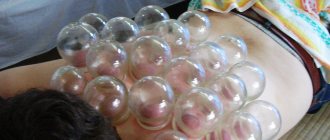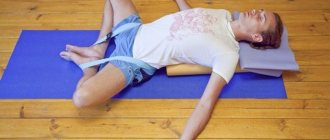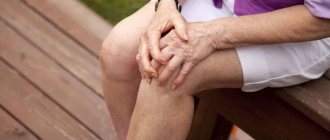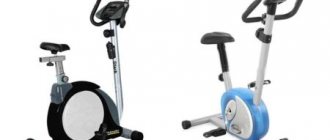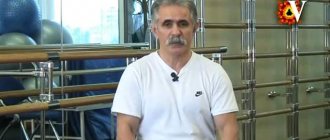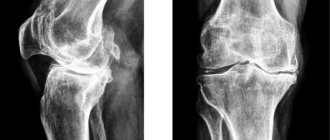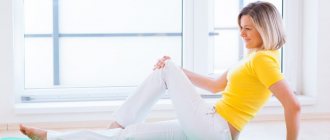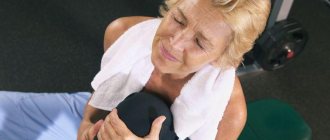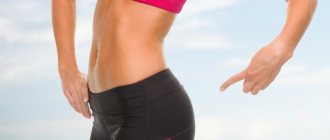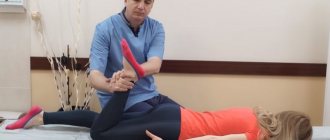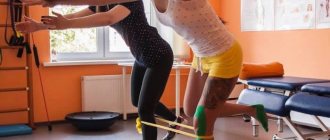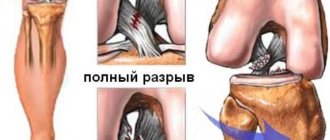How can yoga help with knee problems?
Yoga classes are beneficial for all joints, as special poses bring the entire body into balance. Many exercises strengthen and stretch the muscles in the thigh, calf and ankle, which in turn support the kneecap, keeping it strong. Holding the pose during practice causes a rush of blood through the muscles to the knee area, saturating them with oxygen and nutrients.
This reduces inflammation and speeds up healing. Additionally, yoga poses that require balance strengthen the ligaments and tissues that hold the kneecap in place. For those over 50, it is especially important to perform such exercises, because they will help maintain good knee condition for many years to come. In general, we recommend subscribing and watching our free video lessons on the basics of yoga that will help you restore your body. Here we will give examples of several asanas that are beneficial for the knee joints:
What does comprehensive treatment look like?
Even considering that yoga for arthritis can be quite useful, you should adhere to the comprehensive treatment prescribed by the doctor and often this is physical therapy. In this case, patients are asked not only to take certain medications, but also to perform exercises prescribed by the doctor. In addition to yoga, swimming and other light exercises can also help heal leg joints. The main rule here is not to overload your knees, because with arthrosis this poses a serious danger to your health. This list also includes cycling, which is good for the cardiovascular system, but does not put as much stress on the knees as jogging.
Light gymnastics can also help, because most of the exercises can be performed from a sitting position, and this is important for such diseases in order to avoid unnecessary stress. Like yoga, you need to devote at least 20 minutes to it every day, and then cool down or massage the problem area to increase blood flow to it and reduce the release of lactic acid in the muscles. It would be very good to use warming ointments and massage creams in such massages, including creams prescribed by the attending physician. You can watch a video on the Internet to see how to properly do a warming massage.
Chair Pose
- Take a standing position with your feet together;
- Bend your knees and lower your buttocks down and back, as if you were sitting in a chair. The back must be kept as straight as possible;
- Extend your arms vertically above your head and lower yourself as low as possible. Freeze in this position for 15-30 seconds.
Benefits of exercise
Such exercises involve almost all muscle groups, with particular stress on the muscles of the thighs, calves and legs. The hip, ankle and knee joints are strengthened.
Which type of yoga to choose?
There are many types of yoga. When choosing yoga for the spine, you need to clearly understand the purpose of the classes.
Exercises are divided into:
- asanas that help with displacement of spinal discs;
- asanas for incorrect posture;
- asanas to strengthen muscles.
All exercises are performed statically: a certain pose is achieved, and this position is fixed for some time. Gradually, the fixation time increases - this promotes muscle training.
Types of yoga for the spine
High Lunge
- Stand up straight, look forward;
- Take a big step back with your left foot and lower your body until your right leg forms a right angle;
- Raise your arms vertically up and remain in this position for as long as you can;
- Return to the starting position and repeat, lunging with the other leg.
Benefits of exercise
While you hold the pose, your glutes, quads, and calves are strengthened. The fact that you are trying to maintain balance during the exercise further strengthens this muscle group that supports the knees.
Yoga and joint gymnastics
India gave the world joint gymnastics called Sukshma Vyayama, which prepares for performing the basic physical exercises of yoga - asanas and pranayamas. An approximate translation of the phrase is 'soft warm-up, exercises'. Sukshma Vyayama has many variations. Our most common version of exercises is in the tradition of Dhirendra Brahmachari.
The difference between Indian joint gymnastics and others is that it works not only the physical body, but also the energy and psyche. It harmoniously alternates between relaxation and tension. Along with micro-movements of various parts of the body, such gymnastics trains a person’s attention and works with images and breathing.
The exercises of the complex can be either an excellent preparation for yogic asanas or practiced independently of them, providing a comprehensive healing effect on the body. They are very similar to the movements of the above muscular-articular gymnastics, however, practitioners note a stronger impact and effect of Sukshma Vyayama. If the first is similar to exercise therapy and gives good physical well-being, then the second plus gives energy, self-confidence, inner strength, mobility and endurance.
Eagle pose
- Balancing on your right leg, slightly bent, lift your left leg. Wrap it around your right thigh so that your foot is behind the shin of your right leg;
- Maintain your balance and extend your arms forward. Cross them, with your right hand on top, and then bend your elbows. Make sure that the elbow of your right hand is exactly in the bend of your left;
- Place your palms together and raise your forearms so that your fingers point up;
- Hold the pose for about 30 seconds, slowly come out of it and repeat, replacing the arm and supporting leg with the opposite ones.
The pose is not the easiest, so if you can't do it correctly, try watching others do it on video. With this example before your eyes, you can easily repeat the exercise.
Benefits of exercise
When you intertwine your arms and legs, the muscles in your thigh, calf, and ankle are stretched. Blood circulation improves, joints become more flexible, and the symptoms of rheumatism are alleviated.
Yoga against arthritis
As a result of infection, metabolic disorders, injuries, joints become inflamed, destroyed, deformed, pain in the limbs, stiffness and swelling occurs. In medicine, the disease is called arthritis.
Yoga is a great way to treat arthritis.
In addition to physiological improvement, practicing Eastern philosophy will help reduce stress associated with the disease, reduce pain, and increase the flexibility of articular joints.
Is Eastern practice useful for people suffering from joint disease?
Yoga consists of spiritual, mental and physical practices where a person is able to control the physiological functions of the body through exercise without excessive effort.
Patients with arthritis, while doing yoga, perform a kind of gymnastics. By loading inflamed joints, a person gives them mobility, stimulates regenerative and metabolic processes in the body, thereby restoring cartilage tissue, strengthening muscles and joints, improving blood supply, reducing pain, reducing swelling, toning muscles, and losing excess weight.
Medical studies have shown that with arthritis, those who regularly practice yoga have improved not only their physical but also their psycho-emotional state. Muscle spasms go away, joints work normally - they are mobile.
General recommendations
- You should start your yoga routine with simple and easy exercises.
- Don't try to pull your muscles too hard or twist into difficult poses. Asanas go slowly and smoothly.
- If a pose causes pain, stop moving. Don't let yourself feel uncomfortable.
- Practical classes should be built on a regular basis, i.e. at least four times a week. Then the positive effect is achieved after 6-8 weeks.
- Stop exercising if the pain becomes intense, or if the pain worsens after you finish exercising and does not subside for several hours.
- It is advisable to carry out the exercise under the supervision of a professional trainer - he controls the process of performing the exercises, which will help to avoid injury.
- Do yoga classes in the morning, before your first snack, or after a 2-hour break after your evening meal.
Let's start classes
Nothing should distract you - complete silence without extraneous sounds. Prepare an anti-slip mat (mat), loose-fitting training clothes made from natural textiles. Legs are bare - without shoes or socks. Ventilate the room before starting exercises.
The first step is a light warm-up 10-minute exercise; during this period, the muscles and joints prepare for the load. Do not forget to monitor your breathing - it is smooth and deep, without delays or intense inhalations/exhalations. All movements are slow and smooth, without harshness, without putting pressure on sore joints. It is forbidden to bend/unbend them by force. Relaxation exercises will gently stretch the muscles and give the joints a physical load without damaging them.
Healing techniques
A lot of effective methods have been developed to relieve pain and restore mobility in arthritic diseases. You should not select them yourself; consult your primary care physician or personal trainer - they have experience working with people suffering from joint inflammation. It is enough to perform 2 asanas (postures) per day.
Learn new positions, training time increases gradually. One yoga session – from 30 to 60 minutes.
- Hero pose. Virasana will help with arthritis of the knee and ankle joints, with inflammatory changes in the periarticular tissues that are involved in the movement of the shoulder joint (humeral periarthritis). The exercise tones the muscles and gently stretches them. Get down on your knees, legs apart, sit with your buttocks on the floor (between your heels). Hands lie on your knees, palms up. Keep your back straight, try to pull your shoulders back as much as possible. Hold this position for a few seconds until a slight sensation of pain occurs.
- Bow pose. Dhanurasana will stretch and strengthen the muscles in the shoulder, ankle and knee areas. The exercise is performed on the stomach, the feet of the bent legs are pressed to the buttocks with the help of the hands. Slowly arch your back. 20 seconds is enough to hold yourself in this position.
- Bridge Pose. Setubandhasana will relax the joints of your legs and shoulders. Lying straight on your back, extend your arms down your torso. We bend our knees and begin to lean on our feet and straight arms, raising our torso. 20 seconds and up to a minute is enough to hold in this position.
- Butterfly pose. Titaliasana will help improve blood circulation in the hip area and warm up the joints. The exercise is performed sitting with a straight back. Slowly bend your knees, trying to bring your feet together. Use your hands to pull them closer to your body. We don't bend our back. The knees are spread as far apart as possible. Stay in this position for 40-60 seconds. We slowly and smoothly lower our torso forward, trying to touch our forehead to the floor.
With the help of yoga, they warm up the hands, feet, spine, and prevent deformation, inflammation and pain in the joints.
- We work with brushes: rotate the hands, fingers clenched into a fist. Alternately stretch out the fingers on each hand. Just knock your fists together about 30 times. Perform palm clapping.
- We develop the feet and hip joints. Stand with your feet shoulder-width apart. Bend your leg and lift it, and rotate your foot up to 10 times. We smoothly stand on our toes, lingering slightly at the top. The action lasts 15 seconds.
After classes, you should feel a surge of vigor and energy, and the stiffness of your limbs will gradually decrease.
Do spiritual gymnastics, combining them with body exercises, regardless of age.
Be healthy! Author: K.M.N., Academician of the Russian Academy of Medical Sciences M.A. Bobyr
Frog pose
- Take a lying position, face down;
- Pull your arms back. Bend your knees and clasp your feet with your hands so that your toes point towards your head;
- Raise your upper body and head, stretch forward and up;
- At the same time, press your hands on your feet, pressing them down;
- Hold the pose for 10-30 seconds, then calmly come out of it and relax.
When should you quit classes?
Yoga classes are contraindicated:
- for problems with the circulatory system;
- malignant tumors;
- fever and heat;
- vomiting;
- in the postoperative period;
- for mental illness.
You should also not do yoga after eating. It is recommended to carry out morning workouts immediately after waking up, without breakfast - only a glass of water with a spoon of honey is allowed.
There are no age restrictions for classes. Pregnant women should exercise with caution
Before evening workouts, at least 4 hours should pass after your last meal.
Yoga for knee joints: benefits of exercise
This pose has a strong effect on the knees, strengthening and healing them. In addition, the exercise relieves pain in the knee joint, helps with sprains and flat feet.
These and similar asanas are perfect for people suffering from pain and discomfort in the knee joint, as well as those who have suffered injuries. For those over 50, these exercises are recommended to prevent premature wear of cartilage and keep your knees healthy for as long as possible. It is important to remember that all asanas must be performed slowly and carefully. Take care of yourself, do the exercises correctly and your knees will thank you!
What kind of disease is this?
Before talking about how yoga helps with arthrosis of the knee joint, it is necessary to understand the disease itself, its diagnosis, causes and consequences. This disease manifests itself mainly in old age, so most patients are over 40 years old. Our knee joints constantly withstand colossal loads of the entire body weight, but with arthritis it becomes increasingly difficult for them to do this, so pain in the knees appears during long walking, and gradually it becomes difficult for a person to even get up and sit down. With any movement a characteristic crunching sound appears.
Structure of the knee joint
The reason for all this is the salts that are deposited in the joints and knees throughout our lives, and sometimes a lack of fluid, which leads to impaired functionality of the knee joint. According to statistics, from 7 to 20 percent of the entire world population suffers from gonarthrosis, and it is difficult to cure. Therefore, it is important to identify it in the early stages, when something can still be done, otherwise the consequences can be quite dire. If you begin to notice a crunch in your knees when squatting, especially during physical exercise, and you begin to experience severe pain in this area, you should consult a doctor.
Safety and Nutrition
To avoid achieving the opposite result when doing yoga or other types of physical rehabilitation, you must follow some rules:
- Be sure to warm up your joints and muscles before the main complex with massage and warm-up exercises;
- Do not force an increase in load;
- Use special knee pads or an elastic bandage if necessary.
To the balanced diet recommended by nutritionists for this disease, athletes suggest adding 1 packet of gelatin per day for 3-4 weeks and foods rich in vitamin C. It is not forbidden to consume these foods on an ongoing basis or in courses. Vitamin C and gelatin are beneficial for all body systems.
Arthrosis - causes and symptoms
The definition of arthrosis implies a number of diseases leading to partial or complete immobility of the joint.
In an advanced form, cartilage and bone tissues, ligaments and even nearby muscles can be affected. Arthrosis is often the result of an imbalance between the destruction of cartilage tissue and the production of new material to restore the destroyed structure. Elastic and durable cartilage becomes thinner, becoming rougher. The bone located underneath responds by thickening and spreading outward, deforming the shape of the joint and limiting freedom of movement. Pathological changes also affect the joint capsule. It becomes denser and inflamed. Unhealthy fluid pulls out the capsule and stretches the ligaments. Pain syndrome, and with further development, deformation of the joint, lead to limitation of its mobility and a decrease in the amplitude of movement.
Symptoms
The disease manifests itself as follows:
- Soreness after waking up;
- Acute pain when starting to move;
- Joint stiffness;
- Deformation of the knee bones.
Soreness after waking up
Sharp pain when starting to move
Joint stiffness
Knee bone deformity
Causes
According to the mechanism of occurrence, osteoarthritis can be primary - this is when the etiology of its occurrence is unclear. And secondary, if there is a clear cause of the disease.
There are several reasons:
- Traumatic impact;
- Childhood dysplasia is a congenital abnormality in bone anatomy;
- Various infectious lesions;
- Age-related impairment of the production and metabolism of essential biological substances.
An unhealthy lifestyle and disturbed environmental ecology lead to an increase in the incidence of arthrosis in risk groups.
Risk factors
- Age-related osteoporosis;
- Metabolic disorders;
- Excessive fullness;
- Unbalanced hormone production (menopause);
- Insufficient intake of microelements;
- Congenital and acquired diseases of the skeletal system;
- Cervical or thoracic osteochondrosis;
- Inflammation of the joint;
- Aggressive exposure to chemical toxins;
- Frequent microtraumas of the joint;
- Surgical intervention in the joint structure;
- Increased compression loads due to occupation.
Treatment of arthrosis
Due to the fact that man is naturally endowed with extreme curiosity and inquisitiveness, science will always discover new and new methods of treatment. There are many medical treatments for osteoarthritis, these are:
- Physiotherapy;
- Massage;
- Water aerobics;
- Injections of physiological fluid into the joint capsule.
In recent years, cartilage tissue has been artificially grown and grafted onto damaged areas of the joint. This technology will soon become a simple outpatient procedure available to any patient. But even in this case, it will not be easy for medicine alone to cope with a whole bunch of diseases that usually develop in our country after 40 years. For people who are determined to take charge of their health, an ideal system has long been developed that combines all aspects of knowledge about human nature and provides its adherents with unlimited opportunities - this is yoga.
